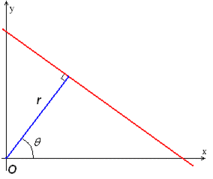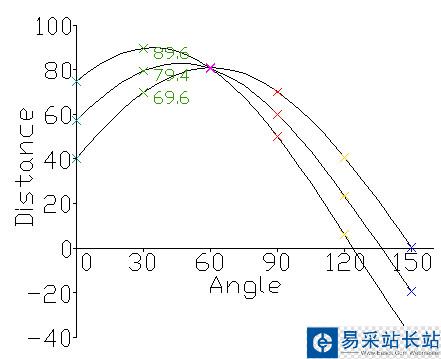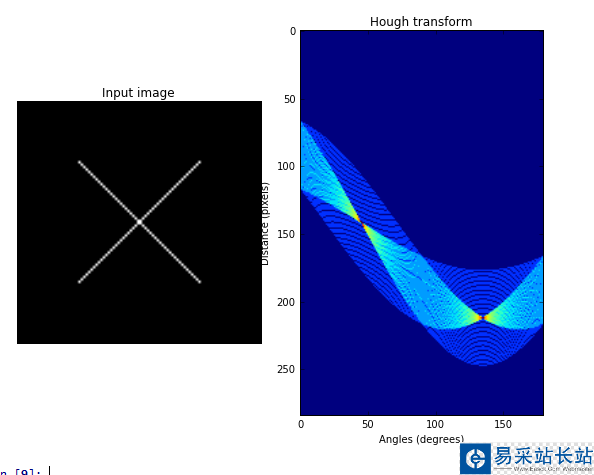在图片处理中,霍夫变换主要是用来检测图片中的几何形状,包括直线、圆、椭圆等。
在skimage中,霍夫变换是放在tranform模块内,本篇主要讲解霍夫线变换。
对于平面中的一条直线,在笛卡尔坐标系中,可用y=mx+b来表示,其中m为斜率,b为截距。但是如果直线是一条垂直线,则m为无穷大,所有通常我们在另一坐标系中表示直线,即极坐标系下的r=xcos(theta)+ysin(theta)。即可用(r,theta)来表示一条直线。其中r为该直线到原点的距离,theta为该直线的垂线与x轴的夹角。如下图所示。

对于一个给定的点(x0,y0), 我们在极坐标下绘出所有通过它的直线(r,theta),将得到一条正弦曲线。如果将图片中的所有非0点的正弦曲线都绘制出来,则会存在一些交点。所有经过这个交点的正弦曲线,说明都拥有同样的(r,theta), 意味着这些点在一条直线上。

发上图所示,三个点(对应图中的三条正弦曲线)在一条直线上,因为这三个曲线交于一点,具有相同的(r, theta)。霍夫线变换就是利用这种方法来寻找图中的直线。
函数:skimage.transform.hough_line(img)
返回三个值:
h: 霍夫变换累积器
theta: 点与x轴的夹角集合,一般为0-179度
distance: 点到原点的距离,即上面的所说的r.
例:
import skimage.transform as stimport numpy as npimport matplotlib.pyplot as plt # 构建测试图片image = np.zeros((100, 100)) #背景图idx = np.arange(25, 75) #25-74序列image[idx[::-1], idx] = 255 # 线条/image[idx, idx] = 255 # 线条/ # hough线变换h, theta, d = st.hough_line(image) #生成一个一行两列的窗口(可显示两张图片).fig, (ax0, ax1) = plt.subplots(1, 2, figsize=(8, 6))plt.tight_layout() #显示原始图片ax0.imshow(image, plt.cm.gray)ax0.set_title('Input image')ax0.set_axis_off() #显示hough变换所得数据ax1.imshow(np.log(1 + h))ax1.set_title('Hough transform')ax1.set_xlabel('Angles (degrees)')ax1.set_ylabel('Distance (pixels)')ax1.axis('image')
从右边那张图可以看出,有两个交点,说明原图像中有两条直线。
如果我们要把图中的两条直线绘制出来,则需要用到另外一个函数:
skimage.transform.hough_line_peaks(hspace, angles, dists)
用这个函数可以取出峰值点,即交点,也即原图中的直线。
返回的参数与输入的参数一样。我们修改一下上边的程序,在原图中将两直线绘制出来。
import skimage.transform as stimport numpy as npimport matplotlib.pyplot as plt # 构建测试图片image = np.zeros((100, 100)) #背景图idx = np.arange(25, 75) #25-74序列image[idx[::-1], idx] = 255 # 线条/image[idx, idx] = 255 # 线条/ # hough线变换h, theta, d = st.hough_line(image) #生成一个一行三列的窗口(可显示三张图片).fig, (ax0, ax1,ax2) = plt.subplots(1, 3, figsize=(8, 6))plt.tight_layout() #显示原始图片ax0.imshow(image, plt.cm.gray)ax0.set_title('Input image')ax0.set_axis_off() #显示hough变换所得数据ax1.imshow(np.log(1 + h))ax1.set_title('Hough transform')ax1.set_xlabel('Angles (degrees)')ax1.set_ylabel('Distance (pixels)')ax1.axis('image') #显示检测出的线条ax2.imshow(image, plt.cm.gray)row1, col1 = image.shapefor _, angle, dist in zip(*st.hough_line_peaks(h, theta, d)): y0 = (dist - 0 * np.cos(angle)) / np.sin(angle) y1 = (dist - col1 * np.cos(angle)) / np.sin(angle) ax2.plot((0, col1), (y0, y1), '-r')ax2.axis((0, col1, row1, 0))ax2.set_title('Detected lines')ax2.set_axis_off()
新闻热点
疑难解答